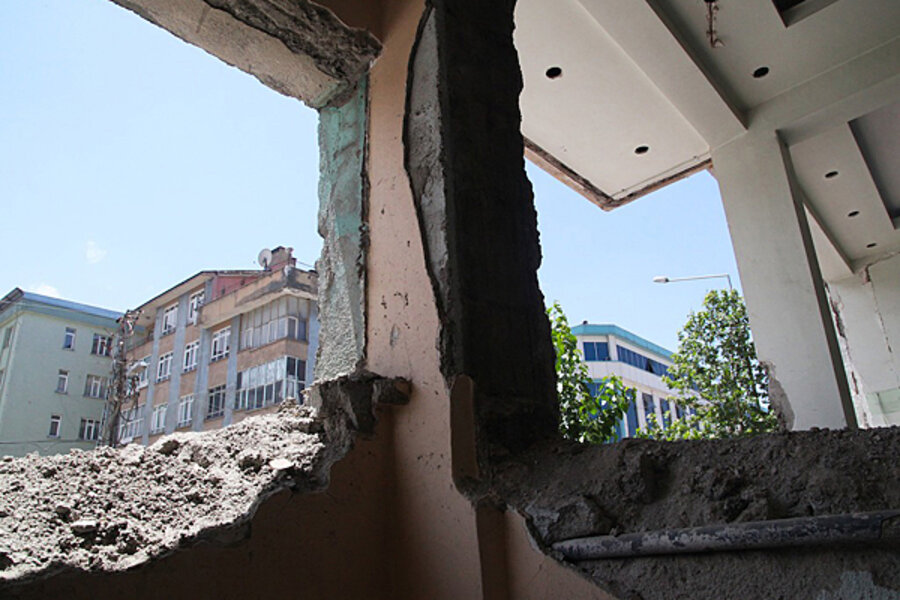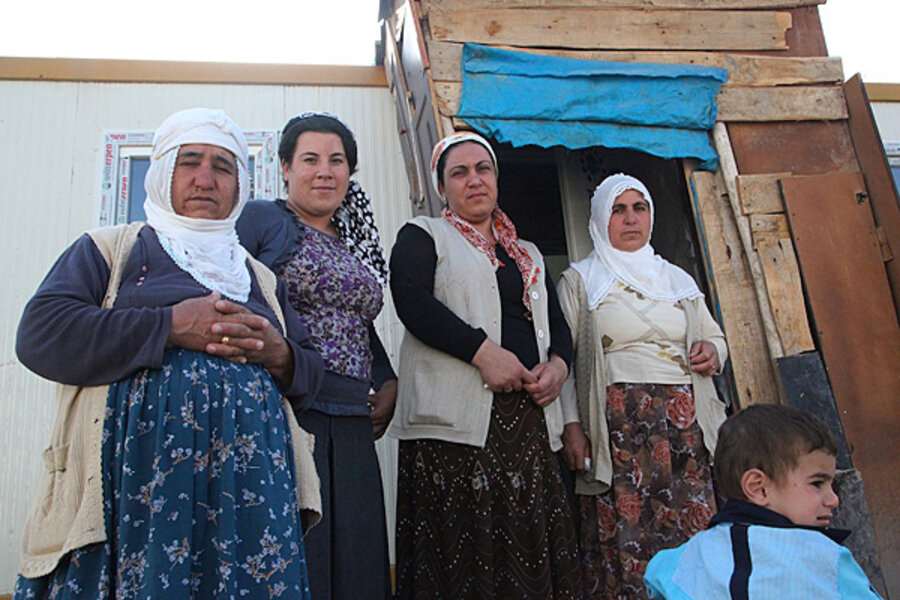After quake, rebuilding community remains biggest challenge for Turkey's Kurds
Loading...
| Van, Turkey
The first earthquake in eastern Turkey’s Lake Van region last October lasted only 40 seconds. The second earthquake, three weeks later, was even shorter.
But nine months on, people here are still recovering from the natural disaster that, in just one minute, wrecked their cities, flattened their villages, and upended their lifestyles.
Now the city of Van has the look and feel of a construction site. Earthmovers and hydraulic drills reshape the landscape, churning up pervasive clouds of dust. Pedestrians pick their way over crumbling sidewalks and past hollowed out buildings awaiting demolition or repair.
The government’s rebuilding efforts are ambitious and well under way, but the needs of more than 60,000 people who have been left homeless extend far beyond the crushed buildings and piles of rubble, say local activists who work with the survivors. The uncertainty of their future has put a strain on daily existence for these mostly ethnic Kurds and taken a psychological toll.
The upheavals and devastation caused by the earthquake in Van are nothing new. Some of the earthquake survivors had only just regrouped after a war between the Turkish military and Kurdish guerillas in the 1990s that killed 40,000 people and displaced at least 1 million.
“This is not our first trauma. Our first trauma was the war,” says Aylin Celik, a sociologist who works with the Van Women’s Association, or VAKAD. “We can recover after the trauma of the earthquake because we are used to it. We can live with change.”
Many earthquake victims will soon have new government-built homes. But the emotional stress of leaving their tight-knit communities has created a number of social problems, particularly for women, who are finding their roles in the home drastically changed. “These women tell us that, for them, the earthquake was a defining moment," says Ms. Celik.
Recognizing the psychological trauma, the Turkish government dispatched 200 psychiatrists and social workers to villages and container cities soon after the earthquake. These specialists have since treated 44,627 families and 276,687 people, according to Van’s disaster and emergency management office.
Re-imagining the home and family
The earthquakes came at the onset of the coldest winter in 20 years, making the tents the government and relief organizations supplied for those left homeless inadequate. By February, most of the survivors were moved to sturdier trailers grouped into about 40 homogenous “container cities” that hug dusty highways around Van and Ercis, site of the first quake. Nearly 30,000 families wait for permanent housing, some living seven or more in each 20-square-meter container.
While the trailers are an upgrade from the drafty tents, life in container cities is not easy. Wives and mothers in particular have found it difficult to adjust to the cramped quarters and the sprawling, anonymous neighborhoods.
“Before the earthquake, women knew and understood the people they lived with,” says Münevver Ölmez of VAKAD, who counsels women inside the camps.
They are finding it hard to connect with hundreds of new neighbors, she says. Ingrained cultural mores and local customs are their biggest hindrance. “If you want to meet someone, everyone wonders, ‘Who is she? Why is she talking to that person?’ ”
Women have also struggled to gain some control over their domestic space. Without proper ovens, they can no longer bake bread at home. Now they must ask their husbands for money to buy it at the store, which requires them to spend more time outside the home than normal. New, unorthodox tasks like these have led to domestic disputes.
The lack of privacy in the containers has also put a damper on marital bliss. And though domestic violence has always been an issue in Turkey, VAKAD’s counselors now see an uptick in violent incidents caused by other family members – mostly in-laws – who share the cramped quarters.
“The earthquake caused problems that are not actually about domestic violence, but which lead to it,” says Celik, adding that VAKAD has referred an unexpectedly high number of women to psychiatrists for advanced counseling.
In the village of Dibekduzu, just outside of Van, Hediye Kara still mourns the loss of her eight-year-old son, who was killed when a building collapsed during a wedding reception. Telling the story in her sister-in-law’s trailer, Ms. Kara absentmindedly strokes the hair of her five-year-old daughter Zara, who was hospitalized for psychological problems after the quake. She says Zara has nightmares and talks about her lost brother. Her husband is inconsolable, and she says she can’t function without medication prescribed by a government psychologist.
“Before the earthquake, my life was very great. But now, I can’t say that my life is any good,” Kara says.
Working through the trauma
In a container city just outside Van, three boys vigorously scrub magic marker off a tabletop as they wait to join an art therapy class run by New York City-based Van Art Project. Outside, children impatiently wait their turn for class, some sticking their heads through the window flap of the big white tent to watch the ongoing workshops.
“They have so much energy. They have to have something to do,” says Leyla Akca, an art therapist. “They love to pull things apart – but they also love to clean.”
“There is so much trauma here,” says Samantha Tomao, another art therapist. “For them, it’s all about destroy and repair – cutting pieces of paper, and then gluing them together. They have a great instinct to repair.”
Trauma reveals itself in many ways. A list of rules tacked to the door warns: “Don’t fight or hurt each other.” But that day, a crying boy is rushed into the office by his friends, blood streaming from a gash in his head. The children were throwing rocks at one another, they confess. One hit the boy in the head.
Esen Günay, who has been working at the camp with VAKAD, says the incident is nothing new. Acts of violence are not uncommon, even among families, and "the parents pass it on to their children.”
Turkish charity Support to Life plans to start teaching survivors communication and anger-management skills, which they will need in the months to come. At the end of the summer, the Turkish government will begin moving the first wave of homeless into the more than 15,000 housing units designated for those whose houses sustained heavy damage.
Built by the Turkish company TOKI, the units cost $22,000 to $38,000 each. Low-interest government loans are available, with no mortgage payments for the first two years.
Though some TOKI buildings resemble low-lying villages, most units are stacked into high-rises with nearby schools, mosques, and shopping centers. They form sprawling housing developments that portend one more dramatic lifestyle shift for survivors accustomed to small communities.
For some, the move is inevitable. In the village of Topaktasi, government engineers deemed the ground unsafe for rebuilding. Villagers have no choice but to relocate to TOKI houses a few miles away, even if, like Ayer Mermit, their houses remained intact, and few of their belongings will be able to go with them.
"No one will be left, so we have to go, too,” she says.








